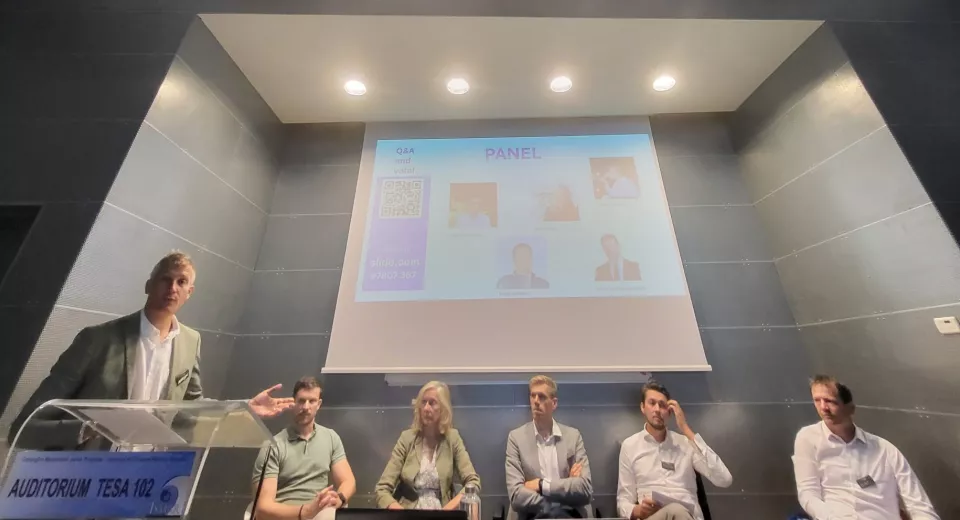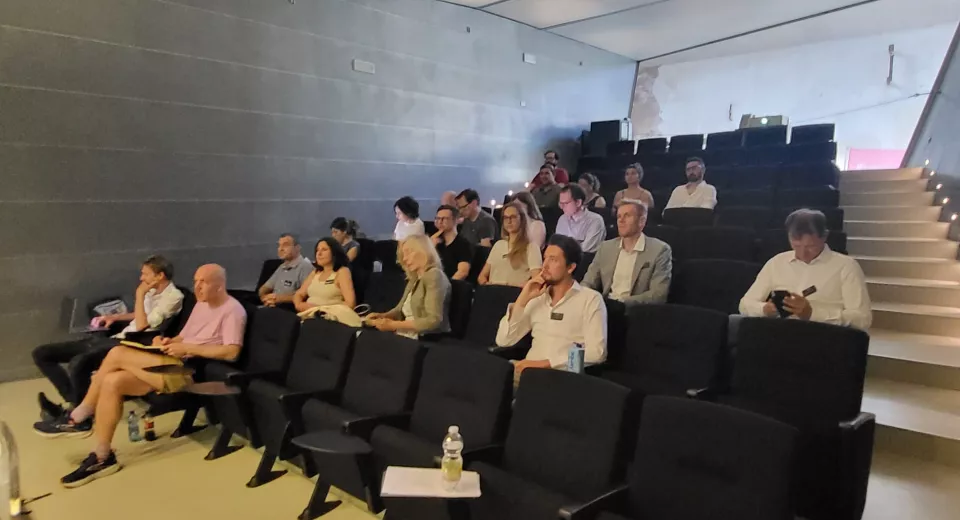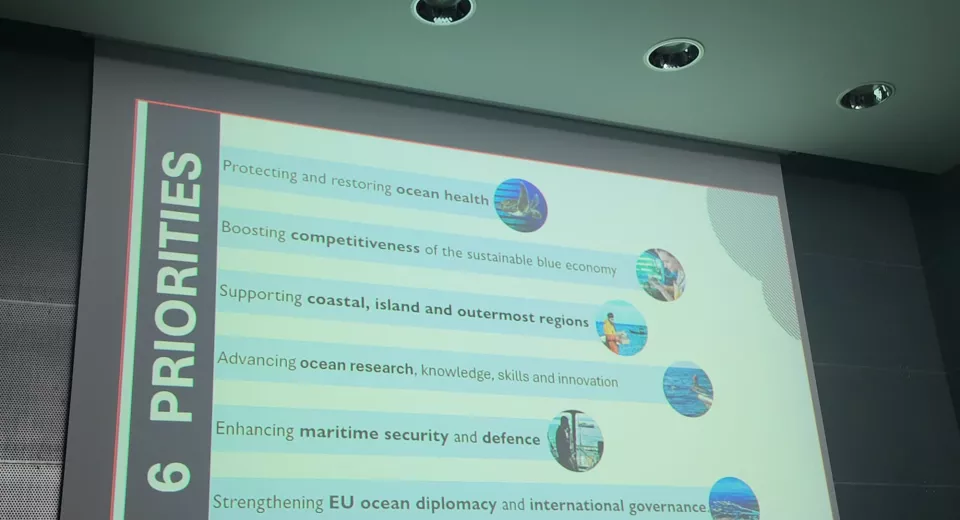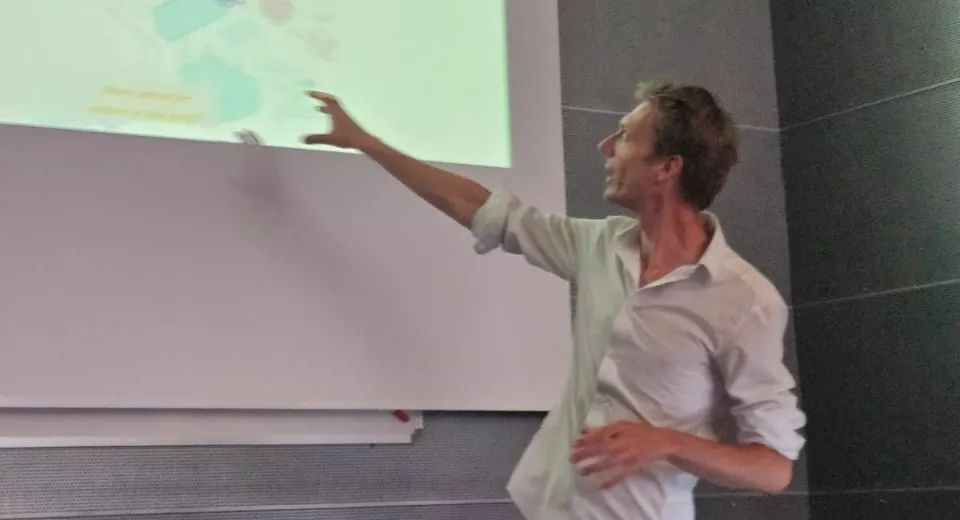Mariparks in the spotlight during multi-use at sea design workshop in Venice
The workshop, organised by Blue Cluster in collaboration with ORG Permanent Modernity, was the first in a series of forward-looking scenario-building exercises. These sessions are intended to shape resilient, multifunctional marine hubs that foster innovation while contributing to biodiversity, energy, food, and security objectives.
A strategic EU push for Multi-Use
Opening the session, Céline Frank of the European Commission – DG MARE highlighted the strategic importance of multi-use in European marine policy. As part of the EU’s broader blue economy objectives, multi-use is no longer optional, but where possible a necessity in light of spatial constraints at sea.
Frank pointed to smart systems and automation as natural allies in this shift, and the enablers in the Mission Ocean, and stressed that what is being explored now in workshops like this is years ahead of current land-based spatial planning models.
The EC will work with Member States to implement multi-use where space is limited. This is not just an innovation challenge, but a governance challenge.
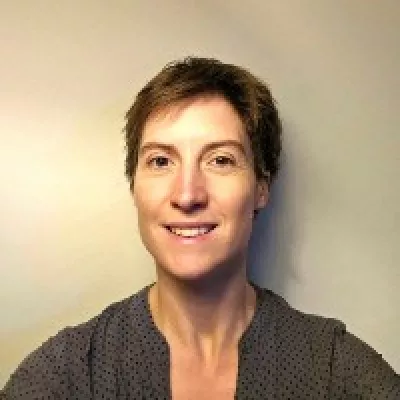
Céline Frank
Key Takeaways from the Venice workbench
Mariparks were presented not as a fixed concept, but as a flexible planning approach: a way to combine multiple marine functions within one well-organised zone. These functions can include renewable energy (such as wind, floating solar, and tidal power), aquaculture, defense infrastructure, and nature-inclusive design (NID) supported by smart technologies. Social challenges and active stakeholder involvement are also key parts of the approach.
Participants explored several possible motivations for developing Mariparks, and were encouraged to reflect critically on their relevance:
- Space at sea is limited, but the urgency and scale of the issue should be placed in the right context as not all areas are under the same pressure.
- The protein transition and food security remain relevant drivers, especially in a geopolitical landscape where conflict has highlighted the importance of local production. However, the business case for marine protein still lacks solid evidence. It’s important to note that policy decisions are not solely based on economic return — agriculture, for instance, has long received support simply to stay viable.
- Energy diversification is essential, particularly in times of global uncertainty. Offshore zones can play a key role in increasing resilience.
- Nature restoration and nature creation are distinct goals and should be treated as such in design processes. Mariparks can contribute meaningfully by offering foraging and breeding grounds, as well as stepping stones that enhance ecological connectivity.
- A shift toward smart aquaculture is crucial to enable integration and scaling within Mariparks. At the same time, less intensive approaches like sea ranching are already feasible and urgently needed.
Panel conclusions
The panel included representatives from Parkwind, Greentide, Capgemini Invent, Shells & Valves, and Oceans of Energy, with lively discussion around feasibility, policy alignment, and technical readiness:
- Jochem Vermeir (Parkwind) stressed that integration must begin in the design phase. Solutions like cable pooling and shared infrastructure only work when they are planned from the outset.
- Kristof Verlinden (Parkwind) highlighted the importance of involving military stakeholders early on - not just to avoid conflicts later, but to unlock synergies such as shared sensors and monitoring systems. “Being present at sea is the best protection,” he noted, suggesting that Mariparks could also contribute to improved maritime surveillance and defense.
- Nancy Nevejan (Shells & Valves) pointed to the immediate potential of low-intensity aquaculture, like sea ranching and nature-inclusive designs that support wild populations. While these methods may yield less, they provide ecological benefits and lower operational risks. She advocated for multi-use marine zones that include areas for foraging and breeding, and emphasized the need for smart aquaculture systems to drive innovation.
- Alexander Jordaens took a more sceptical stance, questioning whether there will be enough demand for commercial mussel or oyster farming by 2030 or 2050. Without a clear business case or willingness to pay premium prices, offshore platforms - especially far from shore - may be hard to justify. He noted that while offshore cultivation could double biomass, it may also double costs. Still, he saw potential for low-intensity aquaculture and nature restoration in multi-use zones.
- Tom van den Nieuwenhuijzen (Capgemini Invent) shared insights from the Netherlands, where cross-ministerial collaboration - spanning food, ecology, defense, coastal protection, and energy - led to a shared vision after nine months of dialogue. He argued for a market-driven approach, supported by practical tools such as funding mechanisms, insurance frameworks, and coherent policies.
- During the public discussion, the idea of a 'gebiedspaspoort”'(area passport) was raised - an early attempt to enable operational multi-use zones in the Netherlands. Although still limited in scale, it was seen as a valuable testing ground for innovation, underscoring the need for adaptive policy and iterative learning.

Looking Ahead
This first workbench session in Venice laid the foundation for further scenario planning and feasibility modelling. The ultimate goal is to develop realistic, scalable Maripark configurations that align ecological ambitions with industrial and strategic interests.
A heartfelt thank-you to our contributors:
- Kristof Verlinden (Parkwind);
- Alexander Jordaens (Greentide);
- Jochem Vermeir (Parkwind);
- Nancy Nevejan (Shells & Valves); and
- Tom van den Nieuwenhuijzen (Capgemini Invent).
With the right tools, partnerships, and ambition, Mariparks can unlock a truly sustainable and inclusive blue economy, balancing the needs of nature, industry, and society at sea.
The NESB project
The NESBp project unites European partners to harmonise maritime spatial planning across the North and Baltic Seas. It promotes sustainable, ecosystem-based management through cross-border cooperation and shared data, aiming for better coordination and practical solutions in the use of marine areas. The project runs from late 2024 to mid-2027.
